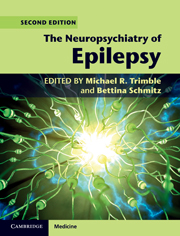Crossref Citations
This Book has been
cited by the following publications. This list is generated based on data provided by Crossref.
Kanemoto, Kousuke
Tadokoro, Yukari
and
Oshima, Tomohiro
2012.
How to cope with psychiatric illness in patients with epilepsy.
Rinsho Shinkeigaku,
Vol. 52,
Issue. 11,
p.
1091.
Bell, Michelle
2012.
Media and Book Reviews: The Neuropsychiatry of Epilepsy, Second EditionEdited by TrimbleMichael R.SchmitzBettina 221 pp., Cambridge University Press, 2011, $99.
Neurology,
Vol. 79,
Issue. 5,
2013.
Neuropsychological Neurology.
p.
97.
Kapfhammer, Hans-Peter
2014.
Depressive und Angststörungen bei Patienten mit Epilepsie und Multipler Sklerose – eine Herausforderung für die nervenärztliche Praxis.
neuropsychiatrie,
Vol. 28,
Issue. 3,
p.
142.
M. Kanner, Andres
2015.
Épilepsie et psychiatrie.
p.
1.
Kapfhammer, H.-P.
2015.
Psychiatrie, Psychosomatik, Psychotherapie.
p.
1.
Branford, David
Bhaumik, Sabyasachi
and
Kiani, Reza
2015.
The Frith Prescribing Guidelines for People with Intellectual Disability.
p.
31.
Алиев, Надир Аббасович
and
Алиев, Заир Надирович
2016.
Селективный активатор нейрональных калиевых каналов флупиртин (SNEPCO) в терапии фармакорезистентной эпилепсии у взрослых.
Psikhiatriya,
p.
41.
2017.
Epilepsy.
p.
32.
Kapfhammer, Hans-Peter
2017.
Psychiatrie, Psychosomatik, Psychotherapie.
p.
2693.
Krishnamoorthy, Ennapadam S.
Natarajan, Subbulakshmy
and
Misra, Vivek
2017.
Epilepsy.
p.
41.
Zafar, Sadia
and
Jabeen, Ishrat
2018.
Structure, Function, and Modulation of γ-Aminobutyric Acid Transporter 1 (GAT1) in Neurological Disorders: A Pharmacoinformatic Prospective.
Frontiers in Chemistry,
Vol. 6,
Issue. ,
Gauffin, Helena
Landtblom, Anne-Marie
Vigren, Patrick
Frick, Andreas
Engström, Maria
McAllister, Anita
and
Karlsson, Thomas
2022.
Similar Profile and Magnitude of Cognitive Impairments in Focal and Generalized Epilepsy: A Pilot Study.
Frontiers in Neurology,
Vol. 12,
Issue. ,





